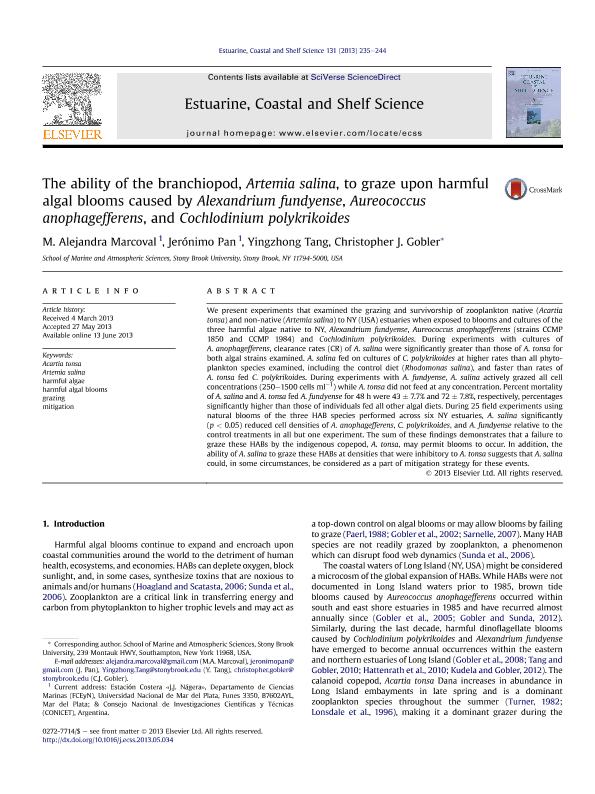Mostrar el registro sencillo del ítem
dc.contributor.author
Marcoval, Maria Alejandra

dc.contributor.author
Pan, Jerónimo
dc.contributor.author
Tang, Yingzhong
dc.contributor.author
Gobler, Christopher J.
dc.date.available
2017-09-28T19:06:13Z
dc.date.issued
2013-06
dc.identifier.citation
Marcoval, Maria Alejandra; Pan, Jerónimo; Tang, Yingzhong; Gobler, Christopher J.; The ability of the branchiopod, Artemia salina, to graze upon harmful algal blooms caused by Alexandrium fundyense, Aureococcus anophagefferens, and Cochlodinium polykrikoides; Academic Press Ltd-elsevier Science Ltd; Estuarine, Coastal and Shelf Science; 131; 6-2013; 235-244
dc.identifier.issn
0272-7714
dc.identifier.uri
http://hdl.handle.net/11336/25321
dc.description.abstract
We present experiments that examined the grazing and survivorship of zooplankton native (Acartia tonsa) and non-native (Artemia salina) to NY (USA) estuaries when exposed to blooms and cultures of the three harmful algae native to NY, Alexandrium fundyense, Aureococcus anophagefferens (strains CCMP 1850 and CCMP 1984) and Cochlodinium polykrikoides. During experiments with cultures of A. anophagefferens, clearance rates (CR) of A. salina were significantly greater than those of A. tonsa for both algal strains examined. A. salina fed on cultures of C. polykrikoides at higher rates than all phytoplankton species examined, including the control diet (Rhodomonas salina), and faster than rates of A. tonsa fed C. polykrikoides. During experiments with A. fundyense, A. salina actively grazed all cell concentrations (250–1500 cells ml−1) while A. tonsa did not feed at any concentration. Percent mortality of A. salina and A. tonsa fed A. fundyense for 48 h were 43 ± 7.7% and 72 ± 7.8%, respectively, percentages significantly higher than those of individuals fed all other algal diets. During 25 field experiments using natural blooms of the three HAB species performed across six NY estuaries, A. salina significantly (p < 0.05) reduced cell densities of A. anophagefferens, C. polykrikoides, and A. fundyense relative to the control treatments in all but one experiment. The sum of these findings demonstrates that a failure to graze these HABs by the indigenous copepod, A. tonsa, may permit blooms to occur. In addition, the ability of A. salina to graze these HABs at densities that were inhibitory to A. tonsa suggests that A. salina could, in some circumstances, be considered as a part of mitigation strategy for these events.
dc.format
application/pdf
dc.language.iso
eng
dc.publisher
Academic Press Ltd-elsevier Science Ltd

dc.rights
info:eu-repo/semantics/openAccess
dc.rights.uri
https://creativecommons.org/licenses/by-nc-sa/2.5/ar/
dc.subject
Acartia Tonsa
dc.subject
Artemia Salina
dc.subject
Harmful Algae
dc.subject
Harmful Algal Blooms
dc.subject
Grazing
dc.subject
Mitigation
dc.subject.classification
Bioquímica y Biología Molecular

dc.subject.classification
Ciencias Biológicas

dc.subject.classification
CIENCIAS NATURALES Y EXACTAS

dc.title
The ability of the branchiopod, Artemia salina, to graze upon harmful algal blooms caused by Alexandrium fundyense, Aureococcus anophagefferens, and Cochlodinium polykrikoides
dc.type
info:eu-repo/semantics/article
dc.type
info:ar-repo/semantics/artículo
dc.type
info:eu-repo/semantics/publishedVersion
dc.date.updated
2017-09-25T17:59:50Z
dc.identifier.eissn
1096-0015
dc.journal.volume
131
dc.journal.pagination
235-244
dc.journal.pais
Estados Unidos

dc.journal.ciudad
New York
dc.description.fil
Fil: Marcoval, Maria Alejandra. Stony Brook University; Estados Unidos. Consejo Nacional de Investigaciones Científicas y Técnicas; Argentina
dc.description.fil
Fil: Pan, Jerónimo. Stony Brook University; Estados Unidos
dc.description.fil
Fil: Tang, Yingzhong. Stony Brook University; Estados Unidos
dc.description.fil
Fil: Gobler, Christopher J.. Stony Brook University; Estados Unidos
dc.journal.title
Estuarine, Coastal and Shelf Science

dc.relation.alternativeid
info:eu-repo/semantics/altIdentifier/url/http://www.sciencedirect.com/science/article/pii/S0272771413002680
dc.relation.alternativeid
info:eu-repo/semantics/altIdentifier/doi/http://dx.doi.org/10.1016/j.ecss.2013.05.034
Archivos asociados
